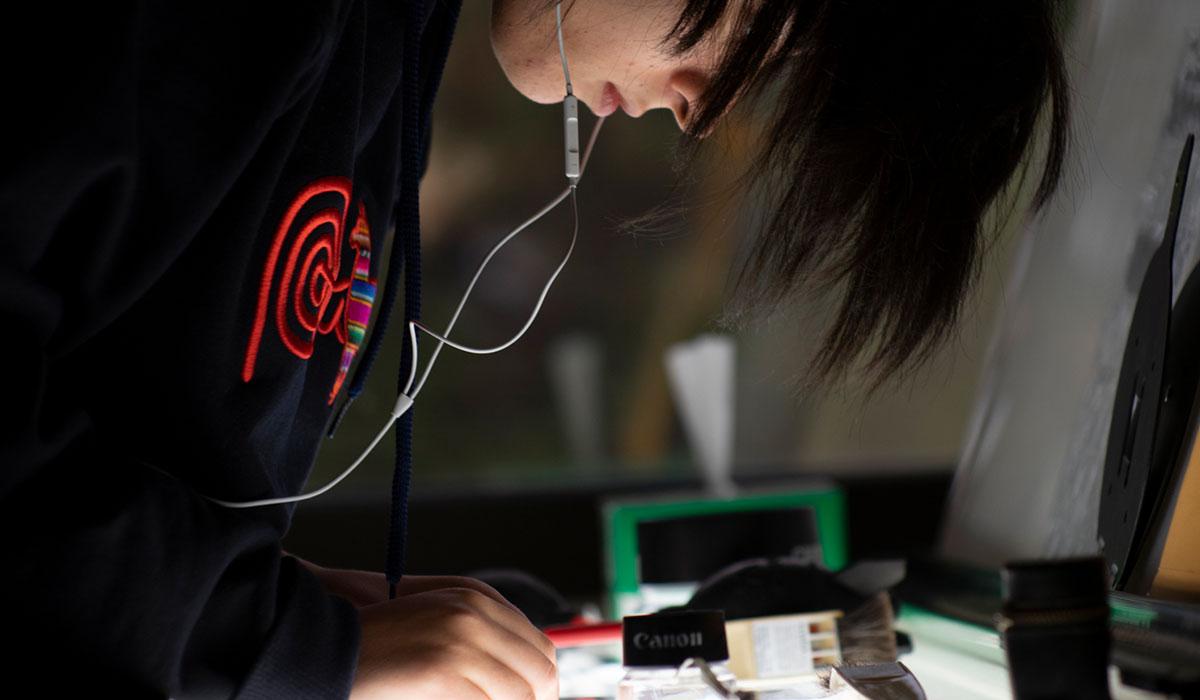
While it’s true that creativity isn’t limited to one particular classroom or forum, one challenge of the COVID-19 pandemic has been its impact on the arts. This fall, TMCC is offering several hybrid classes in the Visual and Performing Arts that will focus on the hands-on instruction that is integral to visual art, photography, graphic arts, dance, theater, and music, while implementing protocols to keep students safe.
And while there will be plenty of protocols and expectations unlike in previous semesters, this hybrid learning mode will allow you to rekindle and reconnect with your creative self through something we haven’t experienced since the move to remote learning: shared space and live-interactions.
“I think so much of what we do is compartmentalized in our lives. When we’re at home, we do home-things. When we’re at work, we do work-things and when we go to certain venues, it’s for that purpose,” said Dance Instructor Dayna DeFilippis. “Calmness and normalcy can come back to us if we get to go to that [dedicated] dance space to practice dance. That can be very powerful, and that I’m looking forward to.”
How Hybrid Learning Works
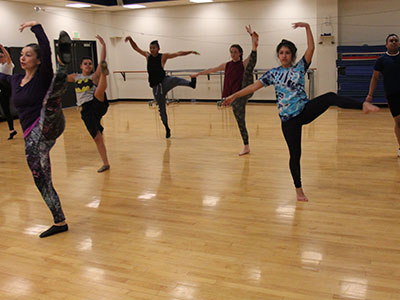
Visual and Performing Arts classes will use social distancing and other safety protocols during in-person class sessions. Photo taken before COVID-19 and does not reflect new protocols.
Art, in many ways, shares the necessity for doing that’s often associated with Career Technical Education (CTE) or allied-health fields. After all, it’s just as important to experience a drawing class in person or to hold a camera and manipulate its settings in order to take a photograph with a certain effect as it is to learn to fix an engine, which by nature is a hands-on proposition.
Yet, how will this work in studio art, theater, music, photography or movement classes? Well, there will be a limited number of students in any given classroom at a certain time. For example, DeFilippis will run each dance class with two “groups” with a specific schedule that will outline which days students will meet for an in-person class session, and which days students will have to join the class virtually (at a pre-set day and time) while the second group attends the in-person session.
Within the classroom space itself, students will be kept six feet apart, and classroom spaces will be outfitted with markings to make that possible. “We’ve also added additional procedures, which include showing up on time for the in-person class, cleaning protocols, temperature checks and running through the COVID-19 checklist and, of course, making sure everyone is wearing a mask,” said DeFilippis.
Additionally, you won’t be able to join an in-person class late, as the door will be locked for student safety. Students who cannot dance while wearing a mask will have the option of taking the class online only—but once students opt to do that, they cannot change their minds to return to an in-class setting.
Despite these changes, DeFilippis is focusing on normalizing the experience in the dance studio for students attending either in-person or virtually. “I want to preserve the physical work and classroom environment as though nothing has changed. Even when a student logs in for the online days via Zoom, I want students to have that same mindset—that you can count on the same class structure and the same class design in terms of exercises and movement expectations and preparing yourself for a movement class,” she said.
TMCC Photography Professor Dean Burton is also preparing for a slightly different semester, which includes meeting with students one-on-one to sign-out the appropriate equipment for the class, a process that he said can take up to an hour per student. Yet, it’s necessary for classes that tend to be “gear-intensive.”
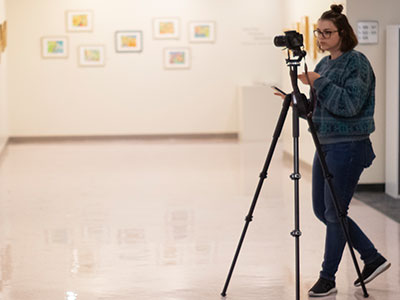
Students who take a photography class will receive hands-on instructions necessary for learning the art of photography.
Burton, who began his career teaching photography classes at UNR, insists on the importance of giving students real-life and hands-on experience. In addition to learning about the “physics of photography”—the need for a lens, light, exposure, etc.—there are also the rule-based, chemical processes of the darkroom and “soft skills” that are lessons which rely on an in-person learning environment.
“I teach a lighting class, which is a kind of portrait class…. And what comes out of that are communication skills, because you really have to communicate to a person what you want them to do and how you want them to move,” said Burton. “I’m also big on having students help me set up the studio, and I teach them how to set up the different light stands, how to attach things safely, and in that way, they are learning about collaboration.”
Skills like collaboration and communication—and how they relate to the Visual and Performing Arts—come from the shared space of a lab or classroom, as long as they are handled safely. “Let’s do this safely and consciously,” said DeFilippis. “This is not ideal, [yet] I am excited to try this and to be on this forefront of a new way to learn. We’re all going to have to embrace that compassionately and seriously …. Our dancers and performing arts students have a tight bond, and I’ve seen that strengthen over my two years at TMCC.”
What You Can Only Learn in a Darkroom
While there are several Photography classes offered in this hybrid format, Art 135 and Art 236 (Darkroom Photography I and II, respectively) offer students in Northern Nevada an opportunity to learn the processes that happen in the darkroom, and are unique among the photography classes because they do not require the student to bring any gear.
“TMCC has the only darkroom in Northern Nevada,” said Burton, who believes that working in a darkroom can change a developing photographer’s views on what constitutes “good” photography.
“It gives students the opposite of ‘Photoshop’... where ‘Photoshop’ has become a verb that means to change something easily. Darkroom shows you that not everything you do can be changed on its own terms… [it makes students] realize that if they take a [bad] photo, that it is going to take them days to make it look the way they want. So... it’s a process that has rules,” Burton said.
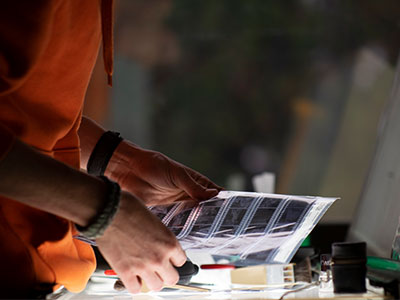
Working in a darkroom teaches students about the importance of taking a quality image and about the rules and procedures of photography.
Yet these processes and rules can provide some solace in a world where work is done almost exclusively on computers and screens. After all, the darkroom is a hands-on lab space that is appealing to students who like detail and procedure. Especially, Burton said, students who are familiar with laboratory procedures like students in Nursing or other allied health fields, because they are drawn to the technical process that is paired with creativity and expression.
“Speak to my students about the higher meaning of their work—that it is an image of a subject, but it’s also more than that,” he said, speaking to the symbolic, metaphoric and expressive possibilities of photographs. Last semester, students in Burton’s classes created books. One was a student’s visual journal of her road trip to Seattle. Pictures on one side of the spread showed close-up images of the gummy bears she was eating to stay awake while the opposite page displayed blurred headlights of on-coming cars. The entire effect of each page of the project was a splash of color and blurred light. Another student created close-up black and white images of mushrooms, images of sharp and strange shapes with “lots of tonality.”
No matter what images you’re developing in the darkroom, that space is a cell phone and computer-free zone—the light from the screen would ruin a developing image. And that, in this time of COVID, might be enough of a reason to take a photography class.
Dancing and Creative Spaces
For the Dance Program, the return to in-person classes will enable students to access an essential element of that discipline, where expression is often nuanced so much so, that it can be lost in the environment of a Zoom call. “The actual physical act of dancing can really only happen at the highest level of instruction and efficiency in a shared space,” said DeFilippis. “I think that’s because, since the beginning of time, we’ve been set up to move with physical people with shared physical space.”
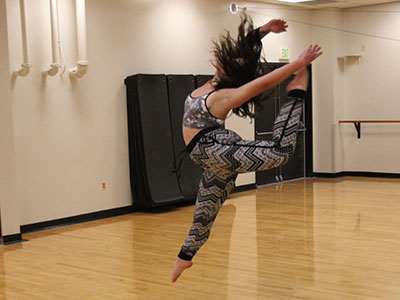
Students in the hybrid dance technique classes can expect to perform exercises and learn choreography. Photo taken before COVID-19 and does not reflect new protocols.
Students who enroll in one of the technique-based movement classes can still expect to perform exercises and learn choreography that they can take home with them. “That in and of itself is enough of a reason to push forward to the new normal to find a solution to honor that tradition, which is… the most effective way to teach this art form,” she said.
Yet another creative innovation from TMCC’s Dance program will be a dance video that will stand in for an in-person dance concert that typically happens near the end of every semester. “We weren’t able to perform a live dance concert last semester, so we are going to move forward with a new kind of performance in the fall by producing a dance film. Basically, it will be a series of small socially distanced rehearsals with a set filming schedule, and then we’ll edit it all together as one cohesive film. We are working to turn this experience into a positive experiment—and experience—that we can use to move forward.”
Liberal Arts Classes Offered in Hybrid Format
If you’re interested in delving into your creativity this fall, the Visual and Performing Arts department is offering a handful of hybrid classes where you can pair the value of in-person instruction with safe social distancing and supplemental online instruction.
Studio Art classes:
- ART 100 Visual Foundations
- ART 101 Drawing I
- ART 201 Life Drawing I
- ART 224 Beginning Printmaking I
- ART 231 Painting I
- ART 211 Ceramics I
Photography classes:
- ART 135 Darkroom Photography I
- ART 141 Digital Photography
- ART 235 Photography II
- ART 236 Darkroom Photography II
- ART 288 Photography of Art and Artifacts
Graphic Arts classes:
- GRC 117 Introduction to Motion Graphics
- GRC 153 Commercial Printing Processes
- VIS 120 Introduction to Animation
Theater classes:
- THTR 105 Acting I
Music classes:
- MUS 203 Music Theory II
- MUS 231 Sight-Singing and Dictation I
Dance Technique classes:
- all sections - Modern, Jazz, Ballet, and Tap (except DAN 101 Dance Appreciation)
For more information about TMCC’s Visual and Performing Arts Department, contact the Visual Arts at 775-673-7291 or the Performing Arts at 775-674-7610.






